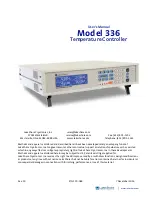
1.1.3 Interface
3
|
www.lakeshore.com
autotuning feature can automate the tuning process. Autotune collects PID parame-
ters and provides information to help build zone tables. The setpoint ramp feature
provides smooth, continuous setpoint changes and predictable setpoint approaches
without the worry of overshoot or excessive settling times. When combined with the
zone setting feature, which enables automatic switching of sensor inputs and scales
current excitation through 10 different preloaded temperature zones, the Model 336
provides continuous measurement and control from 300 mK to 1505 K.
Control outputs 1 and 2 are variable DC current sources referenced to chassis ground.
Output 1 can provide 100 W of continuous power to a 25
)
load or 50 W to a 50
)
or
25
)
load. Output 2 provides 50 W to 25
)
or 50
)
heater loads. Outputs 3 and 4 are
variable DC voltage source outputs providing two ±10 V analog outputs. When not in
use to extend the temperature controller heater power, these outputs can function as
manually controlled voltage sources.
Temperature limit settings for inputs are provided as a safeguard against system
damage. Each input is assigned a temperature limit, and if any input exceeds that
limit, all control channels are automatically disabled.
1.1.3 Interface
The Model 336 is standard equipped with Ethernet, universal serial bus (USB) and
parallel (IEEE-488) interfaces. In addition to gathering data, nearly every function of
the instrument can be controlled through a computer interface. You can download
the Lake Shore curve handler software to your computer to easily enter and manipu-
late sensor calibration curves for storage in the instrument’s non-volatile memory.
Ethernet provides the ability to access and monitor instrument activities via the
internet from anywhere in the world. The USB interface emulates an RS-232 serial
port at a fixed 57,600 baud rate, but with the physical plug-ins of a USB. It also allows
you to download firmware upgrades, ensuring the most current firmware version is
loaded into your instrument without having to physically change anything.
Each sensor input has a high and low alarm that offer latching and non-latching oper-
ation. The 2 relays can be used in conjunction with the alarms to alert you of a fault
condition and perform simple on/off control. Relays can be assigned to any alarm or
operated manually.
The ±10 V analog voltage outputs on outputs 3 and 4 can be configured to send a volt-
age proportional to temperature to a strip chart recorder or data acquisition system.
You may select the scale and data sent to the output, including temperature or
sensor units.
b
Sensor input connectors
c
Terminal block
d
Ethernetinterface
e
USB interface
f
IEEE-488 interface
g
Line input assembly
h
Output 2 heater
i
Output 1 heater
j
Thermocouple
option inputs
FIGURE
1-2
Model 336 rear panel
Summary of Contents for 336
Page 4: ...Model 336 Temperature Controller...
Page 6: ...Model 336 Temperature Controller...
Page 26: ...14 cHAPTER 1 Introduction Model 336 Temperature Controller...
Page 54: ...42 cHAPTER 3 Installation Model 336 Temperature Controller...
Page 84: ...72 cHAPTER 4 Operation Model 336 Temperature Controller...
Page 104: ...92 cHAPTER 5 Advanced Operation Model 336 Temperature Controller...
Page 164: ...152 cHAPTER 7 Options and Accessories Model 336 Temperature Controller...
Page 178: ...166 cHAPTER 8 Service Model 336 Temperature Controller...
















































